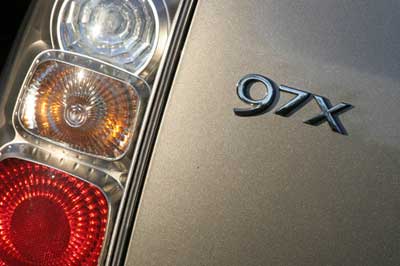Recent Articles
Popular Makes
Body Types
2006 Saab 9-7X Review
More GM than Saab, the 9-7X will struggle for survival
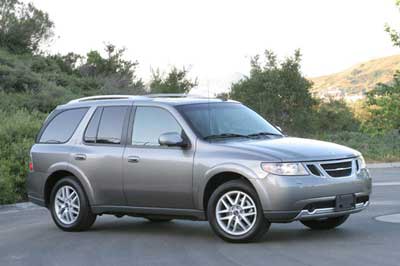
By the time the 9-7X arrived for 2005, Saab was already behind the eight-ball when it came to the SUV market segment. Buyers were already looking at crossovers and station wagons as gas prices began a steady climb, making this rebadged version of the Buick Rainier, Chevy TrailBlazer, GMC Envoy, and Isuzu Ascender an also-ran right out of the gates. So why even bother? General Motors, which owns the former Swedish automaker, possessed market research results determining that Saab owners who left the brand commonly purchased SUVs, so the 9-7X was whipped together to retain those fleeing customers. Based on the GM mid-sized SUV structure, the Saab 9-7X is available with either a 291-horsepower inline six-cylinder or a 300-horsepower V8. Again, you might ask: Why even bother? The biggest difference between the engines is torque. The V6 offers up 277 lb.-ft. of twist while the V8 touts 330 lb.-ft for improved towing and hauling capability. A four-speed automatic transmission drives all four wheels through a standard automatic all-wheel drive system. Other goodies under the 2006 Saab 9-7X include large front and rear vented disc antilock brakes, specially tuned shock absorbers with a front stabilizer bar, and unique 18-inch Dunlop performance tires. Inside the 2006 Saab 9-7X is seating for five with folding split rear seats that expand cargo volume to 80.1 cubic feet. Supple leather covers the seating surfaces, accented by faux wood trim on the dash, door panels and shifter handle. Safety-wise, the Saab 9-7X features dual-stage frontal airbags with a Passenger Sensing System, a rollover sensing system with side-curtain airbags, and front seatbelt pretensioners with load limiters. OnStar is also standard, and can notify emergency personnel when the 9-7X’s airbags deploy to get help to the accident site sooner. The 9-7X does not come equipped with side-impact front airbags mounted in the seatbacks or the doors. For 2006, Saab has added Active Fuel Management to the V8 engine, sophisticated software that reduces the number of firing cylinders by half at cruising speeds in an effort to conserve gas. Other changes for 2006 include more power for the inline six-cylinder engine and a standard Electronic Stability Control system. Buyers can also simultaneously order the power moonroof and DVD entertainment system for 2006, a change from their mutually exclusive status in 2005. A DVD-based navigation system is also optional this year. With Saab coming late to the SUV party, we question whether it can make a go of the 9-7X – and whether loyal buyers will accept the 9-7X into the Saab family. After our week-long test of a 2006 Saab 9-7X 4.2i equipped with the six-cylinder engine, four-speed automatic transmission, and the $800 Prestige Package that includes headlamp washers, adjustable pedals and xenon headlamps, the total cost of our sample 9-7X to just north of $40,000. At that price, and after experiencing this vehicle first-hand, we doubt the Saab 9-7X has what it takes to stand above the competition and retain loyal buyers to the brand. Time will determine the final outcome, but in our collective opinion, this one’s a do-over.
Driving Impressions
Christian Wardlaw’s 2006 Saab 9-7X Driving Impressions: After spending some time behind the Saab 9-7X’s wheel, you’ve gotta wonder why GM couldn’t dial this level of sophistication into the Chevy TrailBlazer and GMC Envoy when they debuted way back in the fall of 2001. Those were sloppy handling SUVs suffering excessive body roll, squat, and dive. By contrast, the Saab 9-7X, which is exactly the same vehicle wearing a different costume, is a reasonably refined piece of work given its basis on one of the least appealing vehicles sold by the Detroit Three today. The 4.2-liter inline six under the hood of our test truck guzzled fuel at an alarming rate, making me wonder why people would bother to skip the available 5.3-liter V8 with Active Fuel Management. The transmission shifted well and responded to requests for added power decisively, but the selector moved through the detents with sticky recalcitrance. The brake pedal is well calibrated, easy to modulate, amenable to making smooth limo stops. The suspension offers a nice ride while simultaneously quelling most of the body motions that can inspire sea-sickness in other iterations of this SUV, and the Saab handled a cloverleaf off-ramp with surprising dexterity and grip. Even the steering was decent for a truck, lacking feel but exhibiting proper degrees of effort and heft off of center. Overall, this isn’t a bad driver, but it’s hardly competitive with many mainstream mid-sizers much less other entry-level luxury suvs. Thom Blackett’s 2006 Saab 9-7X Driving Impressions: Despite having 290 horsepower and 277 lb.-ft. of torque on tap, the 2006 Saab 9-7X 4.2i feels sluggish. The inline six is strong enough to move nearly 4,800 pounds around town with little problem, but get on the gas hard for a quick pass or a spirited sprint when the light turns green, and you’ll find there’s not much in reserve. Worse yet, even when taking it easy I only saw fuel economy climb to 14 mpg. The transmission, on the other hand, feels fairly refined, though it’s an outdated four-speed automatic. Shifts were seamless, but there was a reluctance to downshift quickly on several occasions, causing power delivery to be delayed as I dug deeper into the throttle. Handling is decent for a heavy SUV, and body roll is well controlled. However, get aggressive in the corners and the 9-7X’s front end will plow as the Dunlop tires squeal and relinquish grip. The steering is too light and vague, and the brakes, while effective, required too much pedal travel for full stopping power. On a more positive note, visibility is very good thanks to large windows all around and despite good-sized rear outboard headrests. Wind noise is prevalent around the windshield and front pillars. Ron Perry’s 2006 Saab 9-7X Driving Impressions: I found the 2006 Saab 9-7X to be an enjoyable ride. It is comfortable and quiet with little wind or tire noise and the ride is smooth. In terms of power, the six-cylinder engine we had in our test vehicle did okay for daily commuting but only registered 13.2 mpg during the time we had it. With this kind of fuel economy, why not get the V8? Step hard on the gas and the six could get the job done but was obviously working hard pushing the 4,770 pounds of steel and plastic. The ride is smooth and car-like, as is the steering. The brakes, on the other hand, offer little feedback and many times I found myself pushing harder and harder on the pedal in hopes of getting stopped in time. The transmission shifts are smooth and responsive and the handling wasn’t bad for an SUV. One thing I did find annoying was the load-leveling pump – when it activated, it was very noisy.
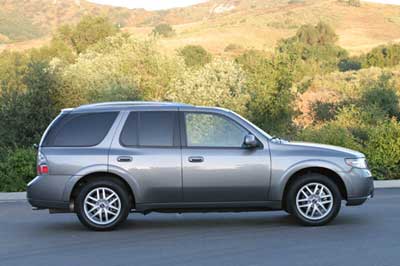
Comfort
Christian Wardlaw’s opinion of the 2006 Saab 9-7X’s Comfort: Saabs are known for comfortable seats, but GM sport-utes are not, so it’s unfortunate that the 9-7X is a gussied-up Chevy. The problem isn’t the driving position, the range of adjustment, or even the design of the seat. It’s the foam padding for the bottom cushion, which offers zero support and gets uncomfortable during a one-hour commute. I can’t image the torture of driving one of these rigs all day long. It’s too bad, really, that Saab didn’t just toss the front chairs from the 9-5 into this vehicle, because otherwise, front comfort is not an issue. In back, leg room is tight, but there’s decent foot space and the short rear cushions are canted to provide decent thigh support. Watch your head when loading cargo, though, because that center latch possesses potential to cause a bruise. Thom Blackett’s opinion of the 2006 Saab 9-7X’s Comfort: Saab may not offer the most powerful rebadged Chevy SUV, though it does offer a comfortable one. Up front are wide, large, heated bucket seats surrounded by padded armrests and upholstered in soft leather. Bolsters are basically non-existent, but that shouldn’t be an issue since the 9-7X isn’t really suited for curvy roads anyway. The driver gets a tilting, leather-wrapped steering wheel with radio controls and our tester featured power adjustable pedals as part of the $800 Prestige Package (they’re standard on the 9-7X 5.3i). Couple that with the power seat, and drivers have a good chance of finding a suitable position. Rear seat passengers are treated to a soft split bench with generous room, though a fold-down center armrest would be a welcome addition. A DVD player is available to entertain riders in back. Ron Perry’s opinion of the 2006 Saab 9-7X’s Comfort: Here is where the 2006 Saab 9-7X shines. I loved the 97-X’s comfort level, from the driving position to the ride and quietness. All of the dials and switches were right where I expected them to be and were easy to operate, although the radio knobs gave me fits the first couple of times behind the wheel because they weren’t well marked and didn’t operate the way I expected them to. The seats could use more side bolstering but were comfortable enough for a long trip. The center padded center console made for a nice place to rest my right arm, complementing the padded arm rest on the door panel for my left arm. Saab also included heated seats with three heat settings on our test truck. Designers need to rethink the cupholder configuration before the next model year though. The main cupholder is small and placed behind the shifter, making it difficult to access. Also, I wouldn’t trust the flimsy fold-away cupholder to keep hot coffee secure. In the back seat, the lack of a center fold-down armrest is a disadvantage, and the cupholders deploy from the lower center console making them hard to reach when buckled in. There is plenty of room for passenger extremities but the mounting hardware for the rear seats interferes with foot room. Rear climate controls are a nice touch, as are headphone jacks. Folding the rear seats is easy but they don’t lay flat and the self-folding headrests continue to be in the way when the seats are laid down. Saab also needs to add height to the tailgate; anyone over 5’8” might bash their head.
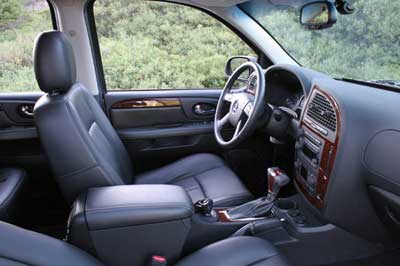
Quality
Christian Wardlaw’s opinion of the 2006 Saab 9-7X’s Quality: Take a close look at the 2006 Saab 9-7X’s interior, and you quickly realize that GM must be incapable of creating a reasonably good mix of quality interior materials, even when a brand’s integrity depends on it. The Saab’s cheap, fuzzy headliner needs to be chucked in favor of a woven mesh, and the gloss levels between the steering wheel spokes and the driver’s airbag cover are way off. That wood is fake and the plastic on the lower dash and door panels is strictly GM grade. Plus, the interior like a GM product and not a Saab, which I think would turn off what few loyalists continue to exist for the brand. Saabs have a distinctive odor inside – the 9-7X is doused in . Assembly quality leaves plenty to be desired, too. That lousy headliner, for instance, is tucked under at the sunroof to avoid the eyesore of a rubber gasket but is also held to the roof by Velcro. The A-pillar covers twist with little effort, the plastic bezels around the door handles pop off with ease, and woodgrain appliqués exhibit inconsistent fit with the dash pad. The exterior was a complete mess. Addressing only the major fit and finish flaws: the front fascia fit at the joint with the right headlight and fender was awful; the gap between the fascia and the left headlight was visibly crooked; the driver’s door was tweaked with an extra large gap at the top leading edge; the door joint at the B-pillar and roof on the passenger’s side could swallow a finger let alone a pen; the driver’s door was bowing out from the rear door on the same side; the rubber window trim around the glass for each rear door was poorly installed; the panel covering the C-pillar on the right side was not mounted flush to the roof; the rear tailgate was tweaked significantly to the left. Evidently, you can take the Saab out of Sweden, you can take the Sweden out of the Saab. Thom Blackett’s opinion of the2006 Saab 9-7X’s Quality: If you’re considering the purchase of a $40,000 Saab 9-7X, think about negotiating $5,000 to $10,000 right off the top for poor materials and build quality. If I were a fan of buzz music, I would’ve loved the tunes playing throughout the cabin, and the fuzzy headliner had the warm, plush feel of a stuffed cardboard dog. The rubber piece surrounding the center ignition popped off in my hand, and the pillar covers indicated their willingness to do the same. Though padded plastics were used on the upper dash, low-rent bits found their way to the doors, lower dash, center console, pillars, and cargo area. Gaps, inside and out, were inconsistent in a number of places, and the front fascia was both loose and misaligned. Ron Perry’s opinion of the 2006 Saab 9-7X’s Quality: Here is where the 2006 Saab 9-7X falls flat on its face. Inside, there weren’t many issues, just loose A-pillar covers and a badly misaligned console. Some of the trim, like the piece under the window switches and the speaker covers, looked really cheap. However, outside there were multiple fitment issues. I honestly have seen better fit-and-finish on rebuilt cars with salvage titles. The seam gaps on the doors varied greatly from side to side and top to bottom. At the rear, the tailgate almost touched the taillight on the driver’s side but had a gap of almost half an inch on the passenger’s side. At the rear window opening there were more misalignment issues, and the rear corner trim protruded out on one side but sat flush on the other. A walk around the 9-7X found bad fitment between the front bumper and fenders, and the entire front fascia could be moved up and down at least a half-inch or more. After being so impressed with the Saab 9-3 during a recent drive, I was disappointed to find the 9-7X lacking quality in so many ways.
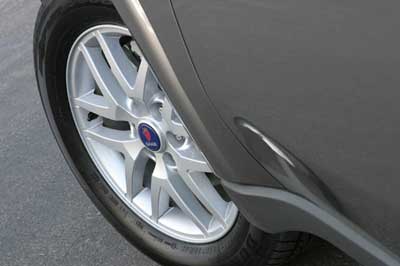
Design
Christian Wardlaw’s opinion of the 2006 Saab 9-7X’s Design: Ask GM what makes a Saab a Saab, and based on the 9-7X they’d likely respond with front styling that recalls the company’s aeronautical heritage, an ignition slot located between the seats, checkerboard air vents, and a collapsing cupholder that deploys from the dashboard. That’s about all that distinguishes the 9-7X from a Buick Rainier, Chevrolet TrailBlazer, GMC Envoy, and Isuzu Ascender. Though the end result is, in my opinion, the nicest looking one of the bunch, and will likely fool most people due to the extensive reworking of the front end, the 9-7X nonetheless represents a definitive low point for a once distinguished and respected brand. Thom Blackett’s opinion of the 2006 Saab 9-7X’s Design: From a purely subjective point of view, the 2006 Saab 9-7X is a much more attractive vehicle than the GM models on which it’s based – the Chevrolet TrailBlazer and the GMC Envoy. The clear taillights are more modern than those on the other GM versions, and the front styling is sleeker and more streamlined. In short, it looks kind of like a Saab, yet after years of being homogenized by General Motors, those meaningless styling cues are all the brand seems to stand for. Interior design is all Envoy with a few token stylistic highlights tossed in to convince Saabophiles, desperately holding onto a disintegrating thread of hope that a sliver of its former self still lives within Saab, that this SUV has the same quirky heart as an old 900. Swivel air vents have been added, as has the requisite center-mounted ignition, which forces the Envoy’s logically placed cupholders to be replaced by the 9-7X’s flimsy pop-out unit on the instrument panel. Ron Perry’s opinion of the 2006 Saab 9-7X’s Design: Overall the 2006 Saab 9-7X’s design is plain and dull. Yes, stylists threw in a few nice details like the taillight design, the contrasting stitching on parts of the leather interior, and maybe the air vents, but there just aren’t enough of them to make you sit up and say WOW! With the big push Saab has on right now with regards to aeronautical design, one might think the 9-7X would have a more streamlined, modern twist. Unfortunately, it’s not so.
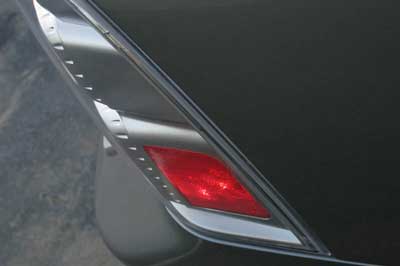
Advice
Christian Wardlaw’s Advice about the 2006 Saab 9-7X: Born from jets. That’s the latest Saab tagline, one designed to convey the company’s heritage and the performance of the fighter planes Saab has built. Unfortunately, the 2007 Saab 9-7X is the aeronautical equivalent of first-class on a 30-year-old Aeroflot Tupolev flown by a pilot who dipped into the vodka within 12 hours of departure time. I cannot recommend this SUV, unless the lease deal is zero down, $300 per month, 12,000 miles annually, for the duration of the three-year free maintenance period. And don’t ask about European Delivery – this Swede is assembled in Ohio by UAW workers concerned that their health-care benefits and pensions are about to get flushed down the toilet. Seriously, the 9-7X is a sorry excuse of a Saab, a vehicle that destroys what little brand integrity was left in this “luxury” marque. If you own a Saab (and who does anymore, really?), spend your forty Gs on a 9-3 or 9-5 Wagon instead – you’ll be much happier. Thom Blackett’s Advice about the 2006 Saab 9-7X: Car buyers should be wary of a brand that has no real purpose. Within General Motors, Cadillac is focused on luxury and performance. Chevrolets are about practicality and value. Pontiac is the performance brand, Buick woos up-market shoppers, Saturn looks to grab import buyers, Hummer is all about off-roading, and nearly every nameplate covers the SUV/utility segment. So what is Saab about, especially within the GM lineup? Obviously, the company has all of the bases covered and then some, so there’s no place or need for Saab, especially a 9-7X that adds little to the GMC Envoy except for a few visual tweaks. Ron Perry’s Advice about the 2006 Saab 9-7X: Don’t walk, from the dealer that tries to set you up in a 2006 Saab 9-7X. There are many superior SUVs on the market that get better fuel mileage and have a better build quality. Saab will suffer greatly from the 9-7X’s poor quality at a time when it least needs it. Brand image is everything, and the 9-7X isn’t a vehicle Saab should have representing it to the public.
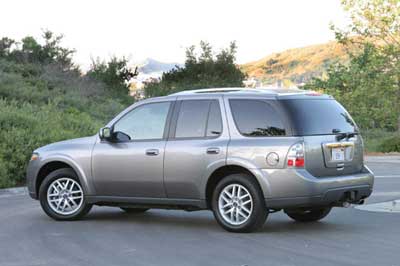
Specifications
Test Vehicle: 2006 Saab 9-7X 4.2i Price of Test Vehicle: $40,040 (includes the $720 destination charge) Engine Size and Type: 4.2-liter inline six-cylinder Engine Horsepower: 291 at 6,000 rpm Engine Torque: 277 lb.-ft. at 3,600 rpm Transmission: Four-speed automatic Curb weight, lbs.: 4,770 lbs. EPA Fuel Economy (city/highway): 15/21 mpg Observed Fuel Economy: 13.2 mpg Length: 193.2 inches Width: 75.4 inches Wheelbase: 113.0 inches Height: 68.5 inches Leg room (front/rear): 41.4/ 37.1 inches Head room (front/rear): 40.2/39.6 inches Max. Seating Capacity: Five Max. Cargo Volume: 80.1 cubic feet Max. Payload: 1,138 lbs. Max. Towing Capacity: 5,500 lbs. Min. Ground Clearance:7.7 inches Competitors: Acura MDX, BMW X5 3.0i, Buick Rainier, Cadillac SRX, GMC Envoy Denali, GMC Yukon Denali, Hummer H3, Infiniti FX35, Jeep Commander Limited, Jeep Grand Cherokee Limited, Land Rover LR3, Lexus RX 350, Mercedes ML350, Mercury Mountaineer Premier, Subaru B9 Tribeca, Volkswagen Touareg, Volvo XC90
Photos by Ron Perry
